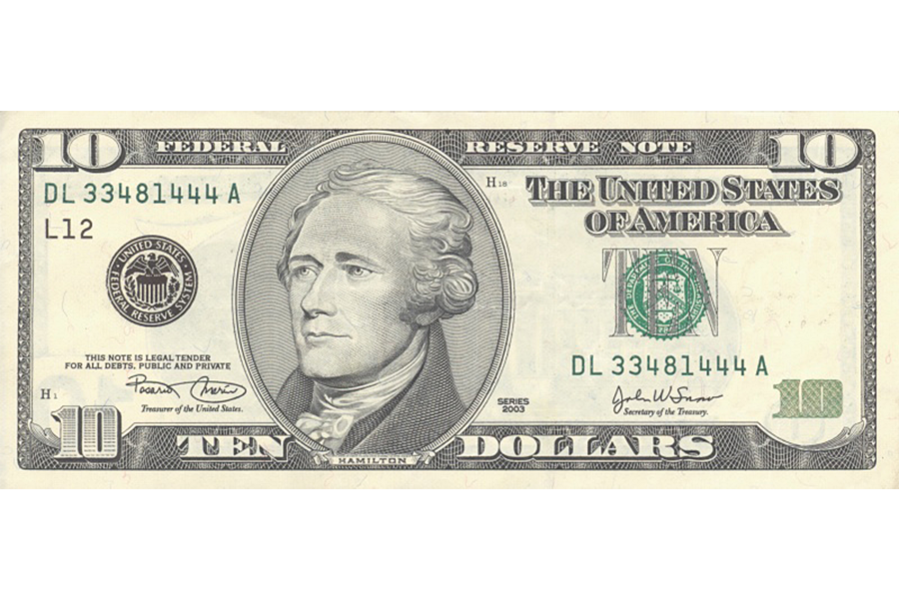Alexander Hamilton safe as Treasury delays choosing woman for $10 bill
Loading...
Alexander Hamilton's days aren't so numbered, after all.
On Friday, US Secretary of the Treasury Jack Lew announced that the Department would delay its $10 bill redesign, slated to put a yet-to-be-determined American woman on paper currency for the first time in over 100 years.
Whoever she is, her portrait will share the 6.14-by-2.61 inch space that has been occupied by Alexander Hamilton since 1929.
The Treasury names "democracy" as the "currency theme" of the next-generation of paper bills, and the agency seems to have gotten what it wished for: Following the June announcement that Mr. Hamilton – the first Treasury secretary and the founder of America's financial system – would have to share the bill with an American woman, more than 1.5 million Americans weighed in in just two months.
The Department had planned to select a woman by January 1, but faced with deluge of public opinion, it now projects making a decision some time next year.
"The public’s input on redesigning our currency has been a valuable part of Secretary Lew’s decision making process," senior Treasury adviser Casey Hernandez said in a statement. "As a result of the tremendous amount of engagement, we have many more ideas than we had originally anticipated."
It's not simply a debate of which woman should get top billing: Hamilton's defenders have come out from the woodwork into the mainstream, thanks in part to blockbuster rap musical "Hamilton;" petitions calling to oust Andrew Jackson from the $20 instead have gone viral; and some wonder what a woman's portrait really accomplishes, anyway.
"We shouldn't change the $10 dollar bill or the $20 dollar bill," Republican presidential contender Carly Fiorina, the field's only woman, said when asked during the September 16 debate:
I think, honestly, it’s a gesture. I don’t think it helps to change our history. What I would think is that we ought to recognize that women are not a special interest group. Women are the majority of this nation, we are half the potential of this nation and this nation will be better off when every woman has the opportunity to live the life she chooses.
According to the Treasury, a currency redesign is needed for security's sake, to protect against counterfeiting, and the $10 bill is just the first scheduled to undergo a facelift. Hamilton was put on the bill right as the Great Depression hit, "designed to restore faith in economic power of the United States."
The change dislodged the seventh US President, Andrew Jackson, who replaced Grover Cleveland on the $20 bill. Jackson remains on the $20 today, much to the chagrin of those who oppose his Native American relocation policies, which killed thousands.
The most recent retouches have emphasized "freedom," such as adding the Statue of Liberty's torch to the $10 background. But today's Treasury aims to make the next set of bills illustrate "democratic ideals, and our striving to make those ideals a reality."
"America’s currency is a way for our nation to make a statement about who we are and what we stand for. Our paper bills...have long been a way for us to honor our past and express our values," Lew said in June.
Names in the running are said to include Rosa Parks, Eleanor Roosevelt, Helen Keller, and Harriet Tubman, among others. An August poll from McClatchy-Marist found that 27 percent favored former First Lady, activist and diplomat Roosevelt, with abolitionist leader Tubman in second place with 17 percent of votes.
Many of the Republican debaters asked whom they'd pick in the September 16 presidential debates seemed to struggle with the question, or not take it seriously: although answers ranged from Rosa Parks, to Margaret Thatcher, to Donald Trump's daughter (although he was torn between her and Ms. Parks), only 55 percent of their nominations were "historically important female Americans," as Slate's Ben Mathis-Lilley observed.
Pocohontas and Martha Washington once appeared on paper currency, but not since the late 1800s. Since then, women leaders like Susan B. Anthony and Sacagawea have been pictured only on dollar coins.
Many who support the idea of a woman on currency would like to see Andrew Jackson's $20 displaced, rather than Hamilton's $10 – in no small part, it seems, due to the success of Broadway's "Hamilton: An American Musical," a rap- and hip hop-based show "about long-dead white men whose solemn faces glower from the green bills in our wallets": so well-reviewed that the New York Times' Ben Brantley wagered would-be ticketholders should "mortgage their houses and lease their children" to see it.
Meanwhile, Jackson's legacy has taken a hit, making the $20 bill an appealing target.
Barbara Ortiz Howard, the founder of the Women on 20s campaign ("A woman's place is on the money"), told Wired Magazine it's important to break the "paper ceiling" to "help shift our cultural perspective on the capacity and abilities of women."
Once the new $10 design is decided on, it will still be at least 5 years until Americans see it in their wallets: had the Treasury announced its female honoree before January 1, 2016, it planned to unveil the actual design in 2020, and then put the bills into circulation.








